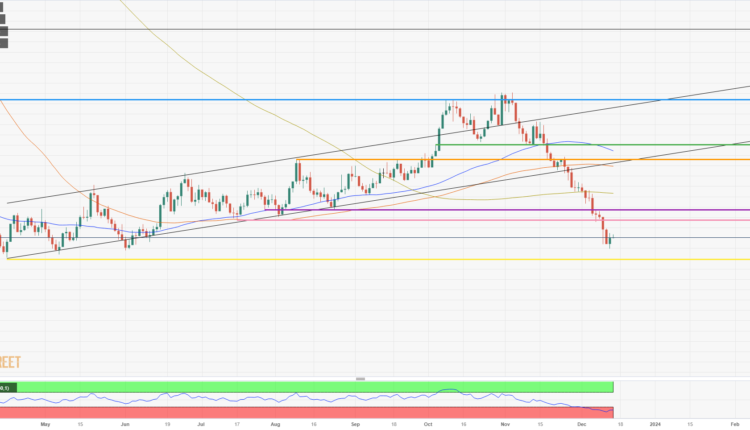Natural Gas nears turning point as OPEC forecast points to supply shortages
- Natural Gas recovered slightly on Wednesday on the back of the Federal Reserve’s interest-rate decision.
- Still, Natural Gas prices look set to head lower toward $2.10.
- The US Dollar has depreciated substantially and traders brace for three major central bank decisions on Thursday.
Natural Gas (XNG/USD) is continuing its decline despite its brief bounce on the back of the dovish US Federal Reserve (Fed) rate decision. Markets cheered the Fed’s signal of upcoming rate cuts for 2024, and OPEC also helped lift Gas prices with a report that pointed to possible supply shortages in the first quarters of 2024. With interest-rate cuts coming, consumers will likely start spending more, triggering higher demand for both Natural Gas and Crude and supporting prices.
Meanwhile, the US Dollar (USD) is set for further volatility on this Super Thursday as the European Central Bank (ECB), the Bank of England (BoE) and the Swiss National Bank (SNB) will release their last rate decisions for 2023. If other central banks turn even more dovish than the Fed, this could make the US Dollar recover recent losses.
Natural Gas is trading at $2.29 per MMBtu at the time of writing.
Natural Gas Market Movers: Who wants to buy?
- Fuel Cargoes carrying Liquified Natural Gas (LNG) are piling up at sea as demand from Europe stalls.
- Updated weather forecast models show milder conditions coming in for Europe.
- Commodity company Trafigura is ramping up buying LNG, with recently buying from Shell with delivery in late January in Northeast Asia.
- Maersk and Mitsubishi Gas Chemicals have agreed to build a supply base for green methanol in Japan. It would be the first supply base built in the country.
- Natural Gas Storage numbers from the Energy Information Administration due to be released near 15:30 GMT. Previous number was a drawdown of 117 billion cubic metres. For this week a drawdown of 54 billion is expected.
Natural Gas Technical Analysis: Time to loosen the elastic band
Natural Gas still has a few cents to go to hit a bottom near $2.10. With the Relative Strength Index (RSI) deeply in oversold territory, the times look ripe for Natural Gas to turn the tide a bit. With the Fed confirming rate cuts, a turnaround for Natural Gas could be seen in early 2024.
On the upside, Natural Gas could return to the purple line near $2.60 as the first hurdle. Next, the 200-day Simple Moving Average (SMA) at $2.74 will act as a resistance before allowing Gas prices to soar to $3 with the 100-day SMA nearby.
Traders are facing further discounts in near-term expirations in Futures contracts, which means more downside to come as buyers will wait for further declines before starting to buy. Small support could be seen near $2.20, with the low of June. Firmer support should come in near $2.10, April’s low, at the yellow supportive line.
-638381489689328960.png)
XNG/USD (Daily Chart)
Natural Gas FAQs
Supply and demand dynamics are a key factor influencing Natural Gas prices, and are themselves influenced by global economic growth, industrial activity, population growth, production levels, and inventories. The weather impacts Natural Gas prices because more Gas is used during cold winters and hot summers for heating and cooling. Competition from other energy sources impacts prices as consumers may switch to cheaper sources. Geopolitical events are factors as exemplified by the war in Ukraine. Government policies relating to extraction, transportation, and environmental issues also impact prices.
The main economic release influencing Natural Gas prices is the weekly inventory bulletin from the Energy Information Administration (EIA), a US government agency that produces US gas market data. The EIA Gas bulletin usually comes out on Thursday at 14:30 GMT, a day after the EIA publishes its weekly Oil bulletin. Economic data from large consumers of Natural Gas can impact supply and demand, the largest of which include China, Germany and Japan. Natural Gas is primarily priced and traded in US Dollars, thus economic releases impacting the US Dollar are also factors.
The US Dollar is the world’s reserve currency and most commodities, including Natural Gas are priced and traded on international markets in US Dollars. As such, the value of the US Dollar is a factor in the price of Natural Gas, because if the Dollar strengthens it means less Dollars are required to buy the same volume of Gas (the price falls), and vice versa if USD strengthens.


Comments are closed.